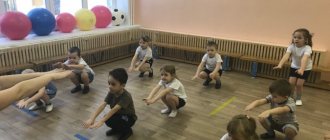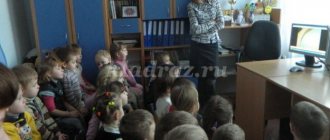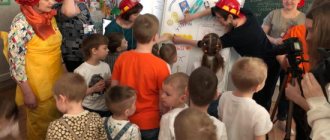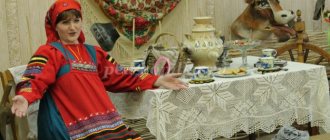Progress of observation
Draw children's attention to fallen leaves. Ask if all trees have the same leaves. Let the children look, compare them by color, shape, and make sure that the leaves of different trees have different colors.
Leaves are falling, falling,
There is leaf fall in our garden.
Yellow, red leaves
They curl and fly in the wind
Looking at the leaves collected by children and selecting the most beautiful ones, ask why the child likes them. During the walk , make a hat, a skirt for a doll, garlands from leaves, folding them in cuttings. Play a game: the children have leaves in their hands, the teacher reads the text, and the children perform movements in accordance with it.
We are leaves, we are leaves, Children stand in a circle, holding leaves in their hands.
We are autumn leaves . We sat on branches
The wind blew and they flew. They scatter along the paths.
We flew, we flew - They run around waving leaves.
All the leaves are so tired.
The breeze has stopped blowing -
Everyone sat in a circle. They squat down and hold the leaves above their heads.
The wind suddenly blew again. They scattered along the path.
And he blew the leaves off the branches.
All the leaves have flown away. They throw the leaves up.
And they sat down quietly on the ground.
Labor activity: collecting colorful leaves.
Goal: to encourage students to independently carry out basic tasks.
Outdoor games:
"Birds in Nests"
.
Goals: - teach to walk and run, scattered, without bumping into each other;
— to teach children to act quickly on the teacher’s signal, to help each other.
"Find Your Place"
.
Goal: to teach how to quickly act on a signal and navigate in space.
Take-out materials: scoops, small toys, sports hoops, pencils, molds.
Walk No. 13
"Watching the Bus"
Objectives: to teach to distinguish vehicles by appearance;
name the main parts of the car;
consolidate behavior skills on the bus.
"Finders" - "searchers".
You can play summer “finders” with your child. On a piece of paper there is an image of various objects that need to be found on the street.
Here are my summer finds (you can download them by clicking on the picture ):
Play detective with your child - try to travel around the area and find all the objects that are drawn in the picture. Found items can be marked with a tick in a special “window”.
And if you like searching and finding, then the book “Finders” will certainly not leave you indifferent . We walk and play - we get to know the world":
Progress of observation:
Invite the children to see if there is sun or clouds in the sky. Ask what the clouds did (cover the sun, note what the sky is (gloomy), what the weather is (gloomy)
.
The winds are blowing, the winds are violent, the clouds are moving, the clouds are dark.
Draw the children's attention to the tops of the trees (they are swaying, the wind is blowing, the trees are swaying. The trees have colorful foliage. If the leaves on the trees have turned yellow, If the birds have flown to a distant land, If the sky is gloomy, if it is raining, This time is called autumn .
Labor activity: watering sand for play.
Goals:
Teach to maintain cleanliness and order in the area, encourage
provide assistance to adults;
to consolidate the knowledge that dry sand crumbles, and if you water it, it becomes wet and you can make pies for dolls from it.
Outdoor games
"Sparrows and the car"
.
Goal: to teach children to run quickly when given a signal, but not to bump into each other, to start moving and change it according to a signal from the teacher, to find their place.
"Take care of the object"
.
Goal: to teach how to act and navigate according to a signal, in space, to develop dexterity.
Individual work: Development of movements.
Take-out materials: watering cans, cubes and molds for each child to play with sand, dolls, cars. Walk No. 2 “Falling Leaves”
Goal: show children the variety of colors of golden autumn ; reveal a new concept of “leaf fall”
.
Progress of observation
Hello, forest, dense forest, full of fairy tales and miracles! What are you making noise about in the leaves on a dark, stormy night? What do you whisper to us at dawn, covered in dew, like silver? Who is hiding in your wilderness? What kind of animal? What bird? Open everything, don’t hide it: you see, we are our own.
On the way to the forest, stop the children in a place where the forest is visible from a distance and is clearly visible. Admire the colorful forest and draw children’s attention to the beauty of the landscape. Find out what color is characteristic of autumn trees .
Labor activity: cleaning the forest area where children will play.
Goal: to teach children to maintain cleanliness and order in the forest.
Outdoor games
1."Birds in Nests"
.
Goals:
learn to walk and run in all directions without bumping into each other;
to teach them to act quickly on the teacher’s signal, to help each other.
2."Find your house"
.
Goal: to teach how to quickly act on a signal, to teach how to navigate in space.
Removable materials: baskets for cones, buckets for collecting garbage. Walk No. 4
"Watching birds while feeding"
Goals: to instill a desire to take care of birds;
develop knowledge about the habits of birds;
cultivate a love for nature.
Games with sticks and stones.
Sticks and pebbles are an excellent material for educational games outdoors:
— You can simply count pebbles and sticks.
— They can be used to decorate cakes and sand cakes.
- You can use them to lay out various figures and silhouettes on the sand.
— With a stick you can draw shapes, letters, numbers and pictures on the sand.
— You can also make letters, numbers, and words from pebbles.
— You can play the game “who is the odd one out” (put three pebbles and one stick in front of the child, let him guess which item is the odd one out. You can also look for the extra item in other combinations: three large pebbles and one small one, three long sticks, one short, three green twigs and one dry, three white pebbles, one black, etc.).
— You can bury a pebble in the sand and ask the child to find it.
Watering can.
If you still haven’t decided to organize your own flowerbed for your child, you can just play with a watering can. Take out a small baby watering can and a bottle of clean water for a walk. Invite your child to take care of the plants that grow in the yard - water them with a watering can. And after watering, weed the weeds near the flower or tree (weeds are easier to remove from soil that is damp after watering). At the same time, have a developmental conversation with your child about why plants need watering, how to do it correctly, how weeds harm plants and how to fight them (we broaden the child’s horizons).
Progress of observation
Observe the dogs being walked by their owners. Describe the appearance of the animal and its behavior. (The dog is very attached to a person, it guards his house, goes hunting with him.)
He is friends with the owner,
The house is guarded.
Lives under the porch
Tail in a ring.
While walking, ask the children who has a dog and who takes care of it.
Labor activity: harvesting grass for animals in a corner of nature.
Goal: to cultivate a desire to care for animals and feed them properly.
Outdoor games
"Shaggy Dog"
.
Goals: learn to move in accordance with the text, quickly change the direction of movement; run, trying not to get caught by the driver.
“Who needs the flag?”
.
Goals: practice jumping forward, climbing through a hoop;
cultivate dexterity and determination.
Take-out materials: dolls dressed for the weather, emblem masks, pencils, signets, scoops, cars.
Walk No. 11
"Introduction to the pedestrian path - sidewalk"
Goals: to consolidate knowledge about the rules of behavior on the street;
develop attention and spatial orientation skills.
Activities and games during summer walks for children 3 years old.
- Seal
Details Author: Nalivaykina Lyudmila Published May 27, 2016
Summer is coming - a time of long walks, gentle sunshine and fresh air. In the summer, staying at home is a real crime - you want to walk as much as possible and enjoy the summer days.
Summer is not a reason to stop working with children. You can also play educational games during a walk in the summer.
Here you will find a selection of educational games and summer activities that can be done outside. Let your motto be “one walk - one educational game” - this pace will not tire either mother or child, and this summer you will not only relax, but also teach your fidget something useful.
One day one letter.
You can quite successfully teach your child letters on the street. There are a lot of games for learning letters outdoors. For example:
— Mom draws a letter on the asphalt with chalk and memorizes it with the child. Then asks him to name words that begin with this letter (on his own or with his mother’s prompts). When the child names a word, the mother draws a picture depicting this word (children love it when adults draw something for them, so drawing is a great way to attract the child’s attention to learning letters).
— Mom draws a lot of letters on the asphalt with chalk, among which will be the letter that the child learned today. The mother asks the baby to find the desired letter among all the letters and circle it (or cross it out). (“Look how many different letters! Find where the letter “K” is hidden!).
— Mom draws letters in chalk at a short distance from each other. Then he asks the child to jump over the letters as if over bumps. When jumping on each letter, the child must remember the word that begins with this letter (the mother can give hints at the same time) or simply remember the name of the letter together with the mother.
— the mother begins to draw a letter with chalk, stops somewhere in the middle, then hands the chalk to the child and asks him to finish drawing the letter.
- the mother draws a letter on the asphalt (so that it can be painted) and asks the child to color this letter with chalk.
- the oldest way of learning letters from our mothers and grandmothers - we study the letters on signs and plates that you see on the street.
Progress of observation
In autumn you can often see sparrows sitting and chirping on telegraph wires or bushes. Pay attention to the children that the birds are going to the cold. Invite the children to feed the birds by pouring bread crumbs on them and watch the birds peck at the food.
Sparrow, what are you waiting for?
You can't peck bread crumbs.
I noticed the crumbs a long time ago
Yes, I'm afraid of an angry cat.
Together with the children, consider the appearance of birds. (The body is covered with down, feathers, there are wings; they fly, jump, peck.)
Work activity: feeding birds.
Goals: to encourage one to independently carry out basic tasks (feeding birds, cleaning the area)
;
develop a desire to care for animals.
Outdoor games:
"Sparrows and the cat"
.
Goals: - learn to jump softly, bending your knees;
run without touching each other, dodge the driver, quickly run away, find your place; teach to be careful when taking up space, and not to push a friend.
"Get in the circle"
.
Goals: improve the ability to act with different objects; develop the ability to throw objects in a certain direction with both hands;
develop eye, coordination, dexterity.
Take-out materials: bird food, dolls dressed for the weather, emblem masks, pencil, scoops, cars.
Walk No. 9 “Watching the Rain”
Purpose: to introduce a natural phenomenon - rain.



